History & Timeline
Use arrows on the right and left sides to go forward or back in time.
You may also drag the content left or right.
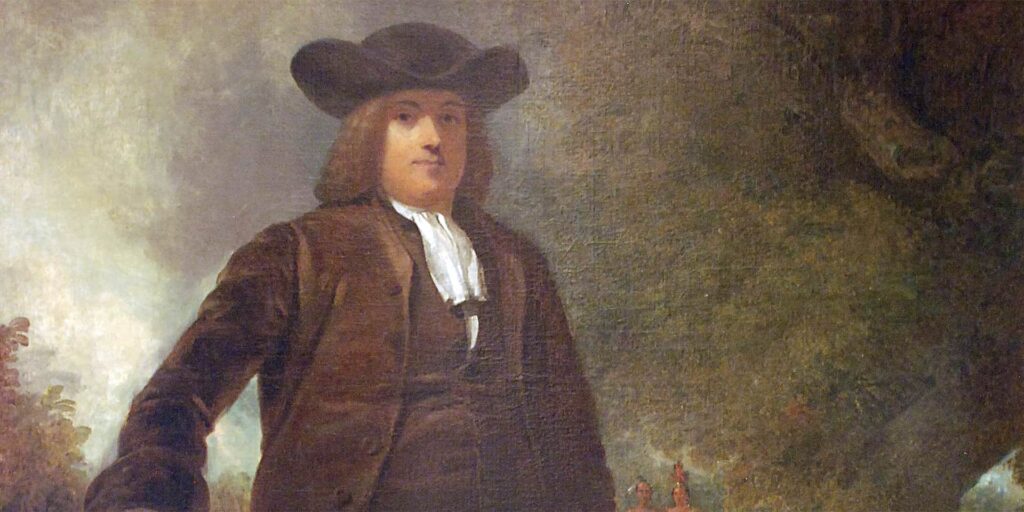
William Penn (1644-1718) purchases a large tract of land, including Princeton and its surrounds, and encourages Quaker families to undertake its settlement. The Olden Family is one of six Quaker families who settle in the Princeton area at Stony Brook.
Image: Portrait of William Penn by Henry Inman, oil on canvas. National Portrait Gallery, Philadelphia.
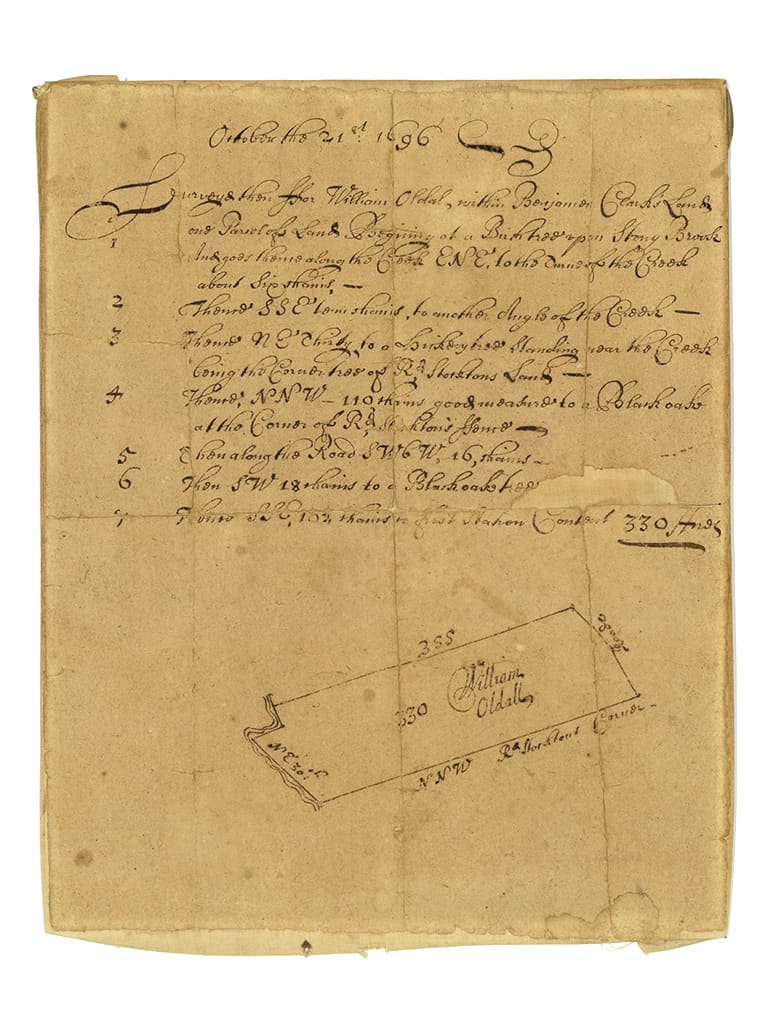
William Olden (1657-1719) purchases 330 acres on the King’s Highway (now Rt. 206) which connects New York City with the largest colonial city, Philadelphia. In 1719, William’s son John Olden (1689-1757) inherits the property and divides it amongst his sons James, Benjamin and Thomas.
Image: Survey of land purchased by William Olden. Reproduced courtesy Historical Society of Princeton
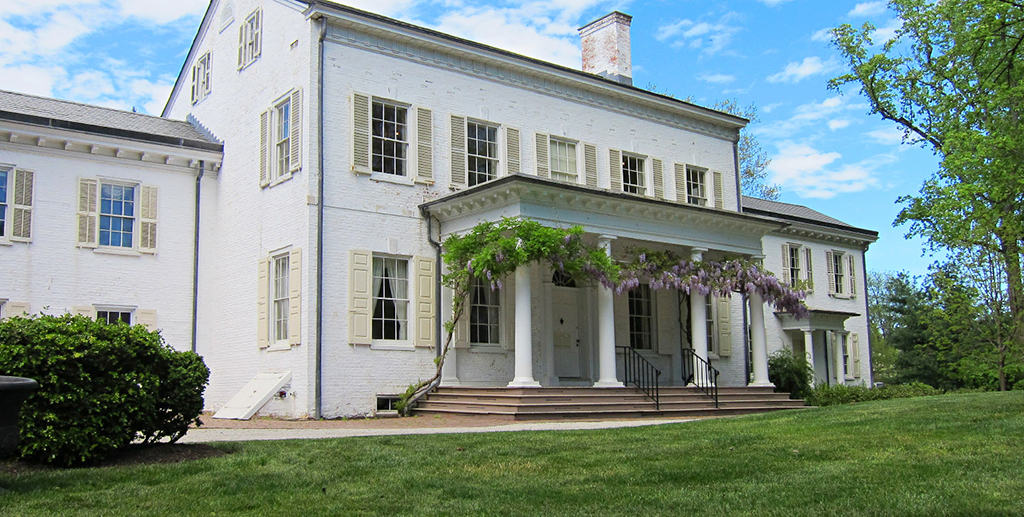
Richard Stockton (1730-1781) builds Morven on land granted to his grandfather by William Penn. Stockton is a graduate of the first class of The College of New Jersey (now Princeton University) which moves from Newark to Princeton in 1756. He is one of five New Jersey delegates appointed to the Continental Congress where he signs the Declaration of Independence. Morven serves as the official residence of New Jersey governors from 1945-1981.
Image: Morven today. Photo Richard Speedy

Thomas Olden (1735-1826) sells his portion of his father’s property to John Hill who, in 1759, begins construction of a small white farmhouse. In 1772, Thomas Olden purchases back the property and farmhouse. The farmhouse, known today as the Thomas Olden House, still stands on the Drumthwacket site and is one of the few remaining original houses in the Stony Brook Quaker settlement.
Image: The Thomas Olden House
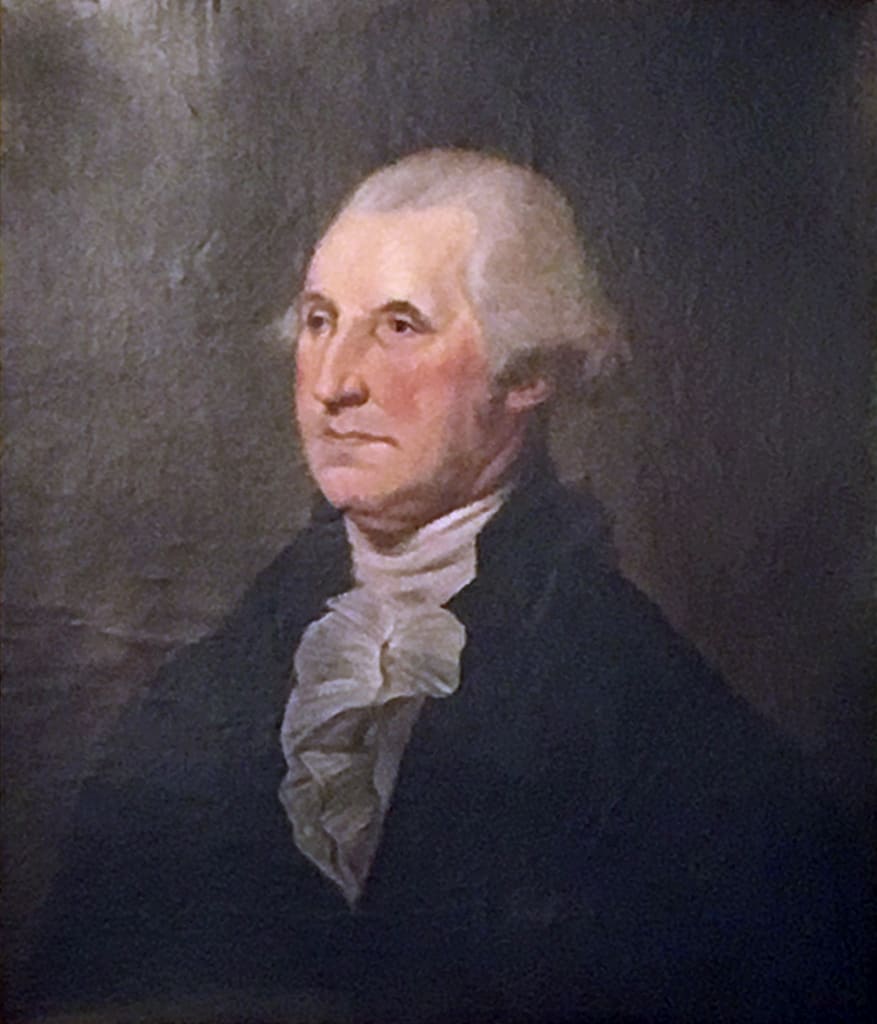
General George Washington’s revolutionary forces defeat British forces near Princeton. Coming at the end of the “Ten Crucial Days” which witness the historic crossing of the Delaware river, the Battle of Princeton is recognized as a turning point in the Revolutionary War and occurs near present day Drumthwacket. After the battle, Washington and some of his men purportedly came to the Thomas Olden House seeking help for their wounded soldiers.
Image: Portrait of George Washington, after Charles Wilson Peale (1741-1827), oil on canvas, Long Term Loan Princeton University Art Museum
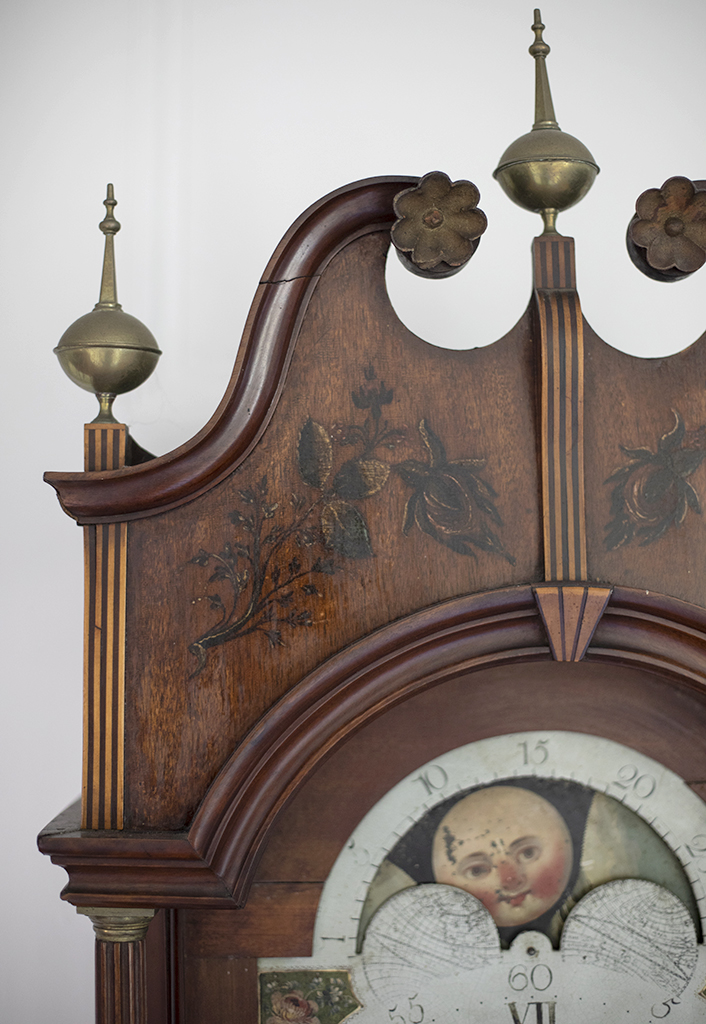
Matthew Egerton Jr. (d. 1837) joins his father Matthew Egerton’s (1739-1802) furniture shop on Burnet Street in New Brunswick, NJ and establishes it as a leading maker of cabinet and clocks in colonial America. The Drumthwacket Foundation’s collection includes seven Egerton works.
Image: Tall Case Clock, bonnet detail, c, 1797. Gift of Betty Wold Johnson & Douglas F. Bushnell. The original label inside the waist door reads, “Made and sold by Matthew Egerton, Junior, Joiner and Cabinetmaker, New Brunswick, New Jersey.”
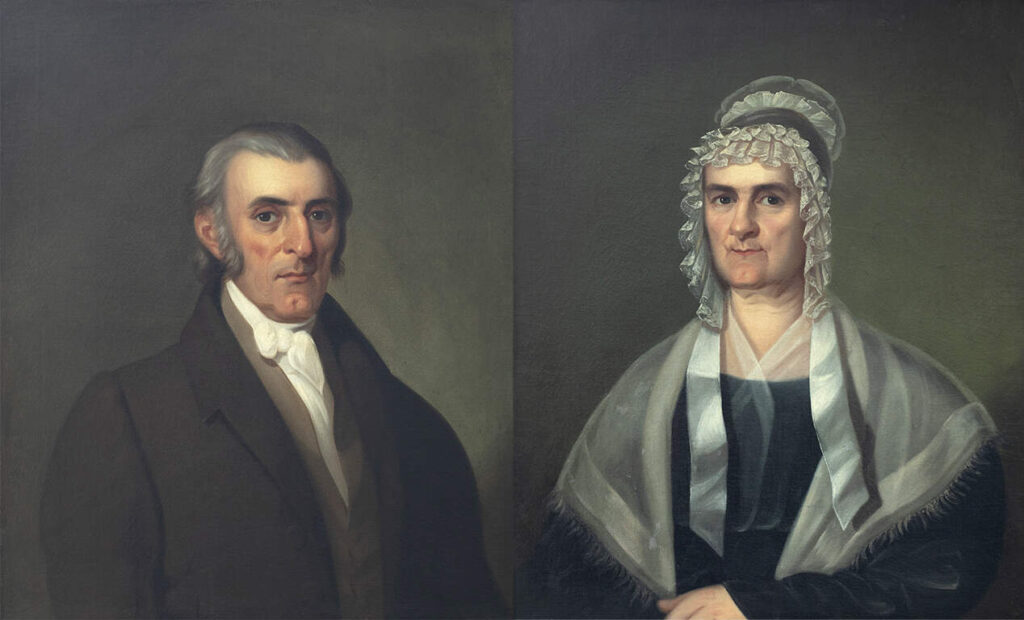
Thomas Olden’s grandson Charles Smith Olden (1799-1876) is born on the Olden farmstead. Charles is one of seven siblings born to Hart (1767-1841) and Temperance Smith Olden (1755-1841.)
Image: Portraits of Hart & Temperance Olden, artist unknown, oil on canvas. Inscription on reverse reads, “Painted in Princeton, 1810.” Gift of Mrs. Heather Williams and Mr. and Mrs. C. Donald Carroll.
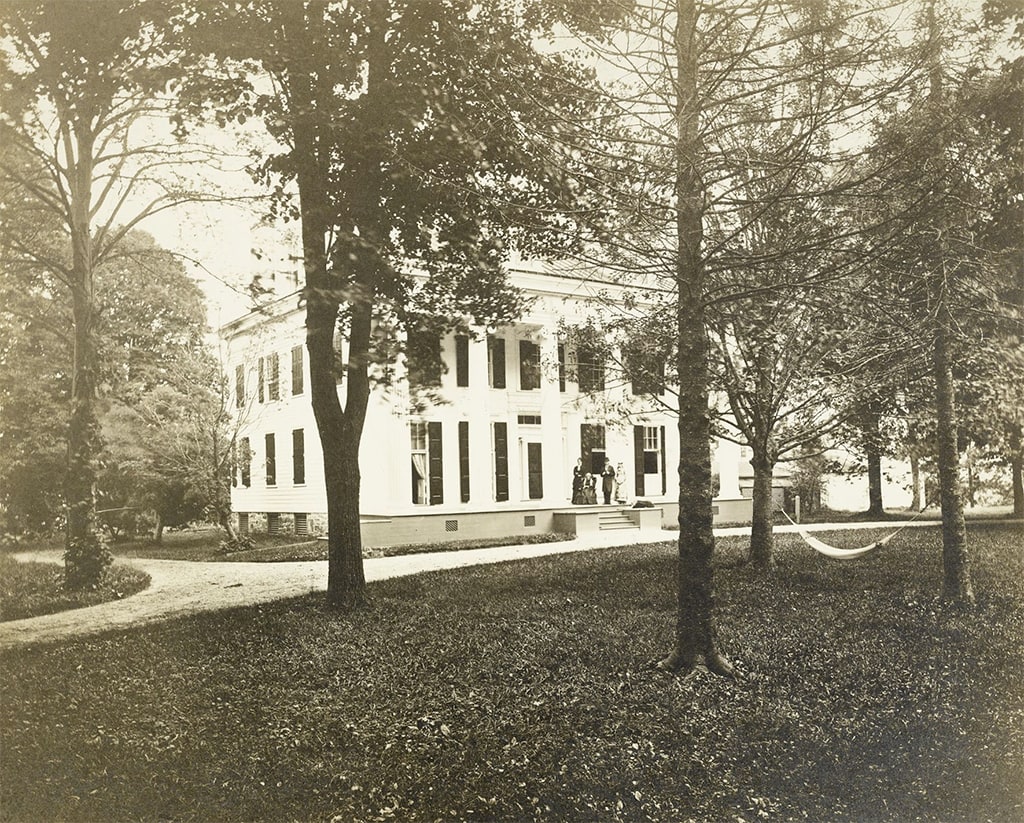
With savings and a bequest from Charles Smith of New Brunswick, for whom he was named, Charles Smith Olden purchases his grandfather’s property and begins construction of Drumthwacket. The original structure consists of the center hall with two rooms on each side in addition to the large portico with detailed ionic columns. Olden gives the home the Scots-Gaelic name “Drumthwacket” which translates to “wooded hill.”
Image: Drumthwacket, mid to late 19th century.
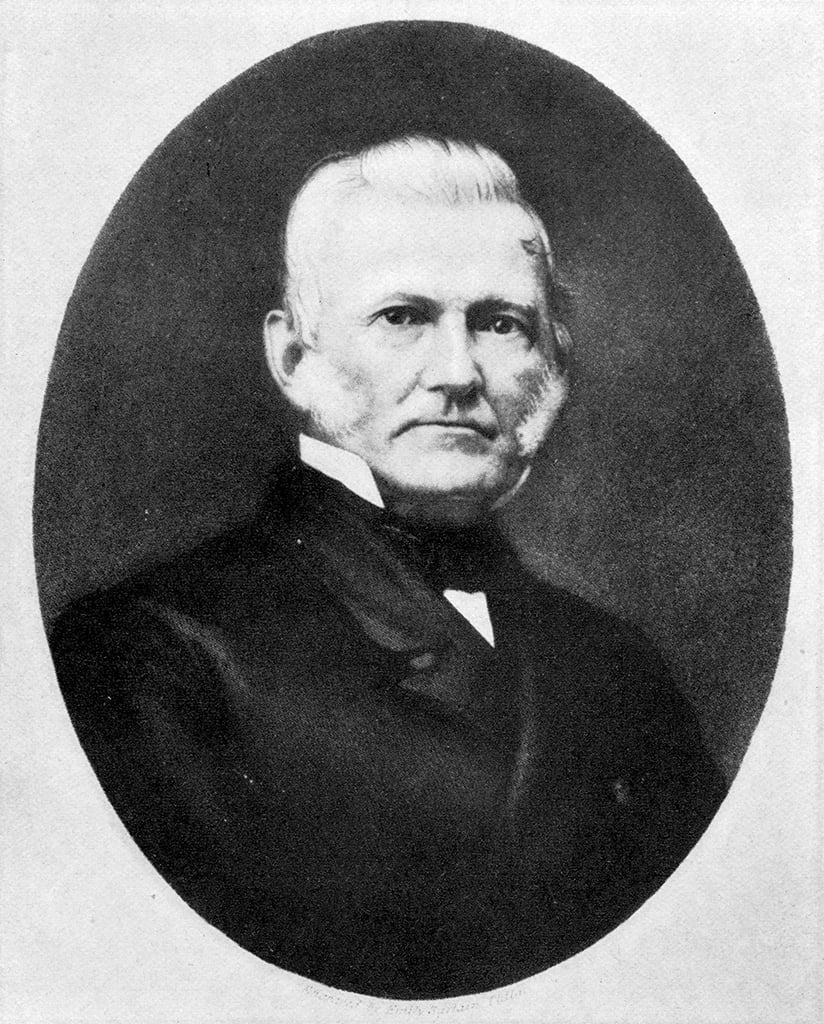
Olden serves as the 19th Governor of New Jersey from 1860–1863. When the Civil War begins, he keeps New Jersey on the Union side and updates the military organization and equipment of the New Jersey troops. He reorganizes the state’s finances and sustains the treasury with his private fortune.
Image: Charles Smith Olden. Reproduced courtesy Historical Society Princeton.
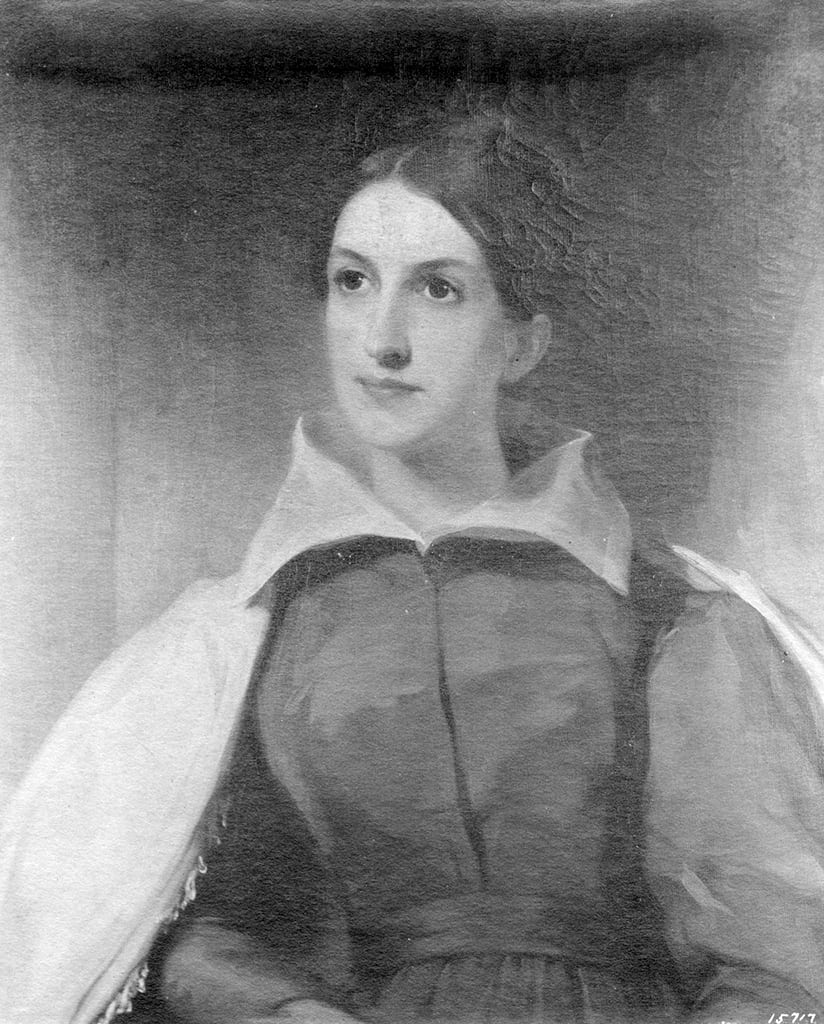
Charles Smith Olden dies and is buried at the Stony Brook Meeting House and Cemetery. In his will of 1873, he leaves his lands that included 48.20 acres valued at $167,000 along with Drumthwacket and the small white farmhouse to his wife Phebe Ann Smith (d. 1892.)
Image: Portrait of Mrs. Charles Smith Olden, 1830. Thomas Sully (1783-1872.) Frick Digital Collections.
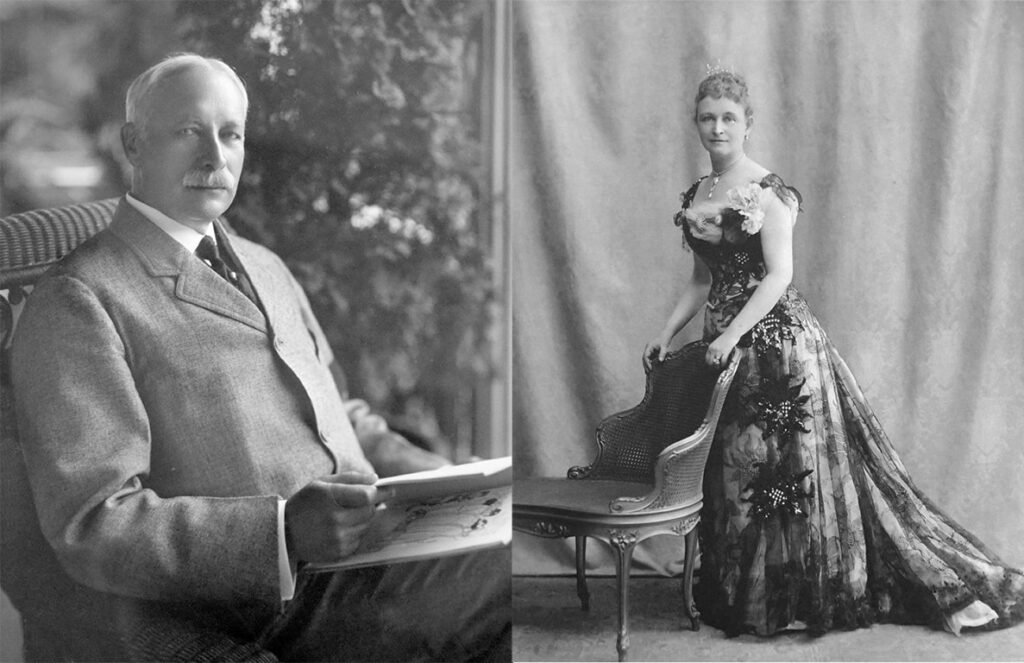
Moses Taylor Pyne (1855-1921) purchases Drumthwacket from Governor Olden’s widow for the sum of $15,024 and with his wife Margaretta Stockton Pyne (1856-1939) begins the process of transforming Drumthwacket into a grand estate.
Image: Moses Taylor Pyne and Margaretta Stockton Pyne
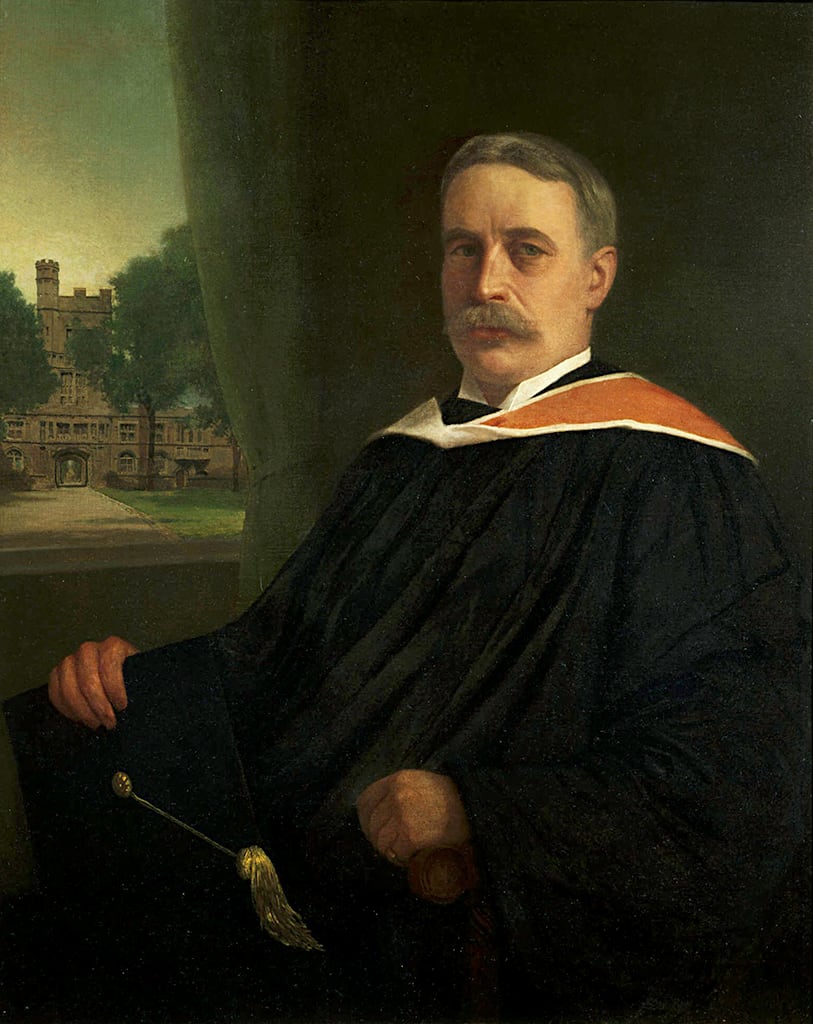
Moses Taylor Pyne celebrates tenure as a Trustee of Princeton University, a position which he holds for 37 years. He is instrumental in bringing Woodrow Wilson to Princeton as president, and after a disagreement, having him removed.
Image: Portrait of Moses Taylor Pyne. William Sartain (1843-1924), oil on canvas. Long term loan Princeton University Art Museum. Moses Taylor Pyne is seated in academic gown with a view of Princeton University’s Pyne library in the background.
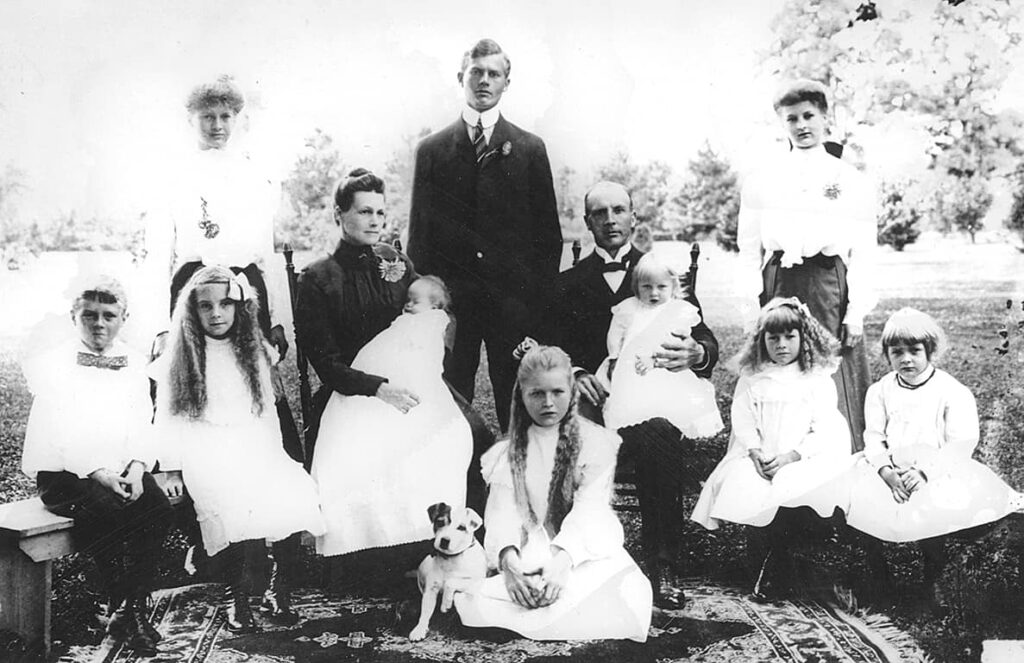
The Thomas Olden House is converted to an aviary for exotic birds and houses monkeys when Henry Egglesfield, butler to Mr. Pyne, his wife and 11 children outgrow the small farmstead. Mr. Egglesfield serves as Moses Taylor Pyne’s English Butler for forty-eight years.
Image: Photograph of Henry Egglesfield, his wife Fanny and 10 of their 11 children.

Noted architect Raleigh C. Gildersleeve is engaged to design the alterations and additions to the residence which include east and west wings. Gildersleeve also designs McCosh Hall at Princeton University in addition to several eating clubs and the Upper and Lower Pyne dormitories.
Image: The East wing, shown, was added first to the residence.
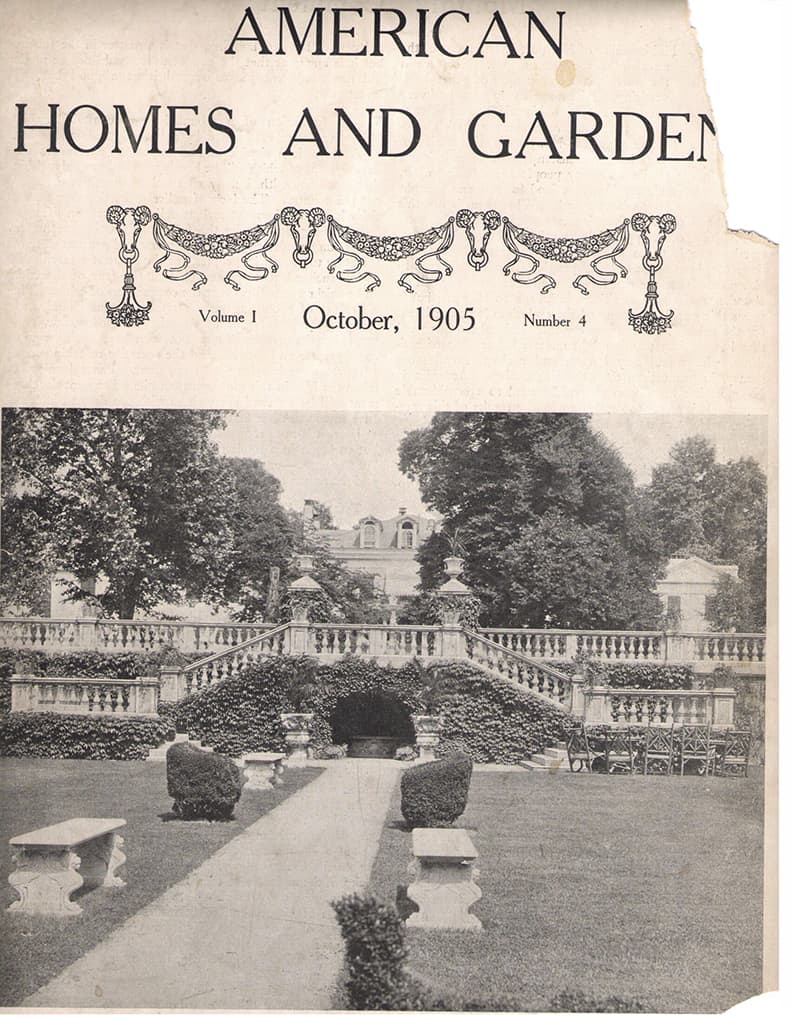
Moses Taylor Pyne retains Daniel Webster Langton, one of the eleven founding members of the American society of Landscape Architects, to design Drumthwacket’s entire property including woods, ponds, lawns, bowling green, fountains, tennis court and the formal Italianate gardens directly behind the residence.
Image: October 1905 cover of American Homes and Garden featuring the Drumthwacket estate.
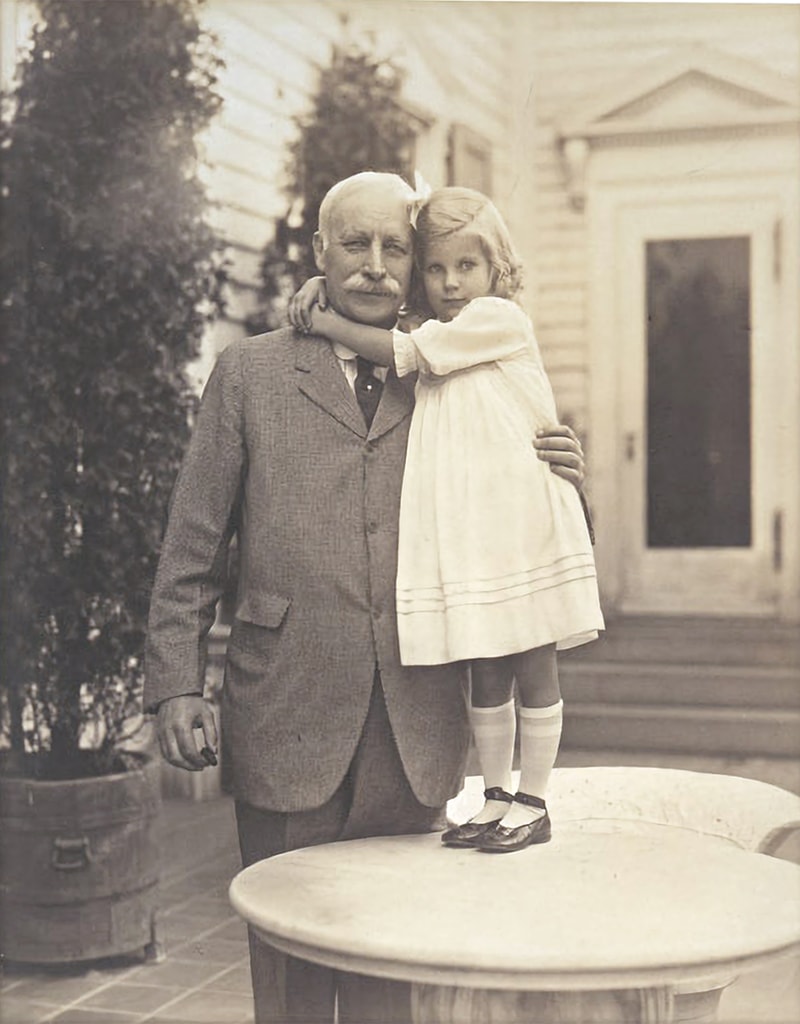
Moses Taylor Pyne dies and bequeaths Drumthwacket to his only grandchild Agnes. Princeton University suspends classes for the day and bells toll throughout Princeton in memorium.
Photograph of Moses Taylor Pyne and his granddaughter Agnes, n.d.
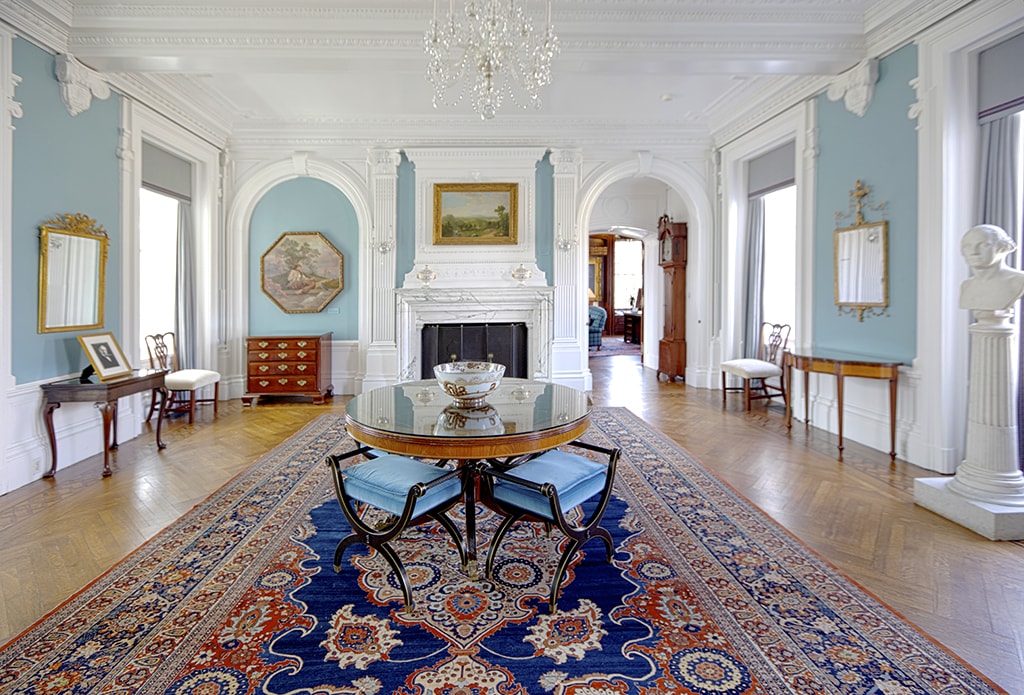
Abram Nathanial Spanel (1901 – 1985) purchases Drumthwacket and twelve surrounding acres from Moses Taylor Pyne’s granddaughter, Agnes. A Russian immigrant, Spanel is an ingenious inventor and scientist who founded in 1932 the International Latex Corporation which becomes known as the International Playtex Corporation. Spanel’s company supports American efforts in World War II with latex products such as attack boats, life rafts and canteens.
Spanel’s engineering staff lives at Drumthwacket and many of his patented inventions are conceived in what is today the Music Room. When Spanel dies, he holds more than 2,000 patents including a pneumatic stretcher designed to carry wounded military personnel over water and a home hair-cutting device, among others.
Music room. Photo Credit: Andrew Wilkinson

Hungarian-born physicist Leo Szilard (1898 – 1964) lives at Drumthwacket for over a year by invitation of Abram Spanel and his wife Margaret. A close friend and colleague of Princeton resident Albert Einstein (1879-1955), Szilard urges Einstein to sign the historic 1939 letter to President Franklin Roosevelt warning about German nuclear weapons research.
Image: Portrait of Albert Einstein. Samuel Johnson Woolf (1880-1948). Oil on canvas. Gift of Bernard and Bebe Perliss. The portrait is featured on the April 4, 1938 cover of Time magazine. Einstein graced the cover of Time magazine on six separate occasions including the December 31, 1999 issue in which he is named the “Man of the Century.”
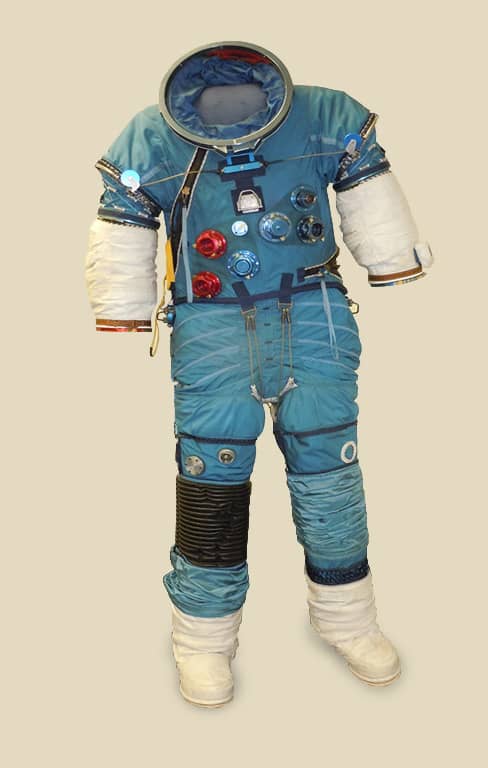
Abram Spanel’s company wins a competition sponsored by NASA to develop the Apollo spacesuit. In an address to ILC employees, Abram Spanel remarks, “it is the greatest privilege of my life to present to you the role that your company played in that colossal of all human achievements in placing two American astronauts on the surface of the moon for the glory of civilization and humanity.”
Image: Custom-made by ILC employees as a training suit for Astronaut Paul Weitz who flew aboard the Skylab II mission in 1973. The suit is identical to all of the suits that were used on the Apollo 15, 16 and 17 lunar missions. Collection of ILC Industries, Dover, Delaware.
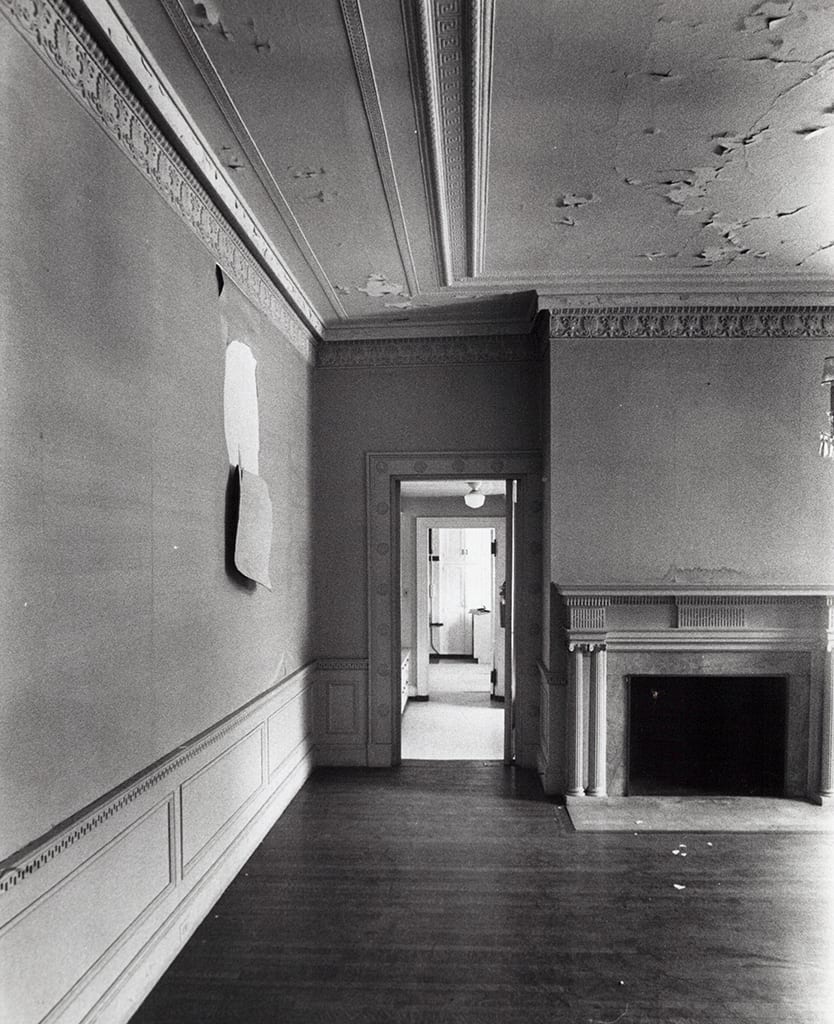
The State of New Jersey purchases Drumthwacket with the intent that it be used as the governor’s residence although it is not officially recognized as such until 1981 when adequate funds are raised for much-needed maintenance and restoration.
Image: The dining room at Drumthwacket prior to restoration. The center wall will be removed to accommodate a table that can seat 24.
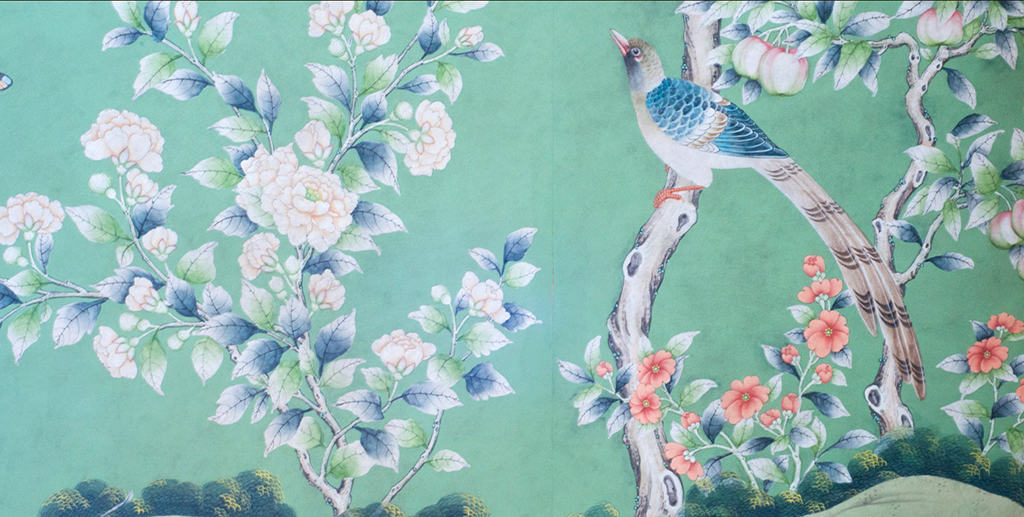
The Drumthwacket Foundation is founded accepting the responsibility of restoring, curating and preserving the residence and property which are listed on the National Register of Historic Places.
Image: Hand painted wall panel, detail. In 1982, The Foundation commissioned 29 separate hand-painted wall panels for the residence’s dining room. The design consists of plum blossoms, peonies, butterflies, bees and birds. In the Chinese tradition, plum blossoms represent strength and braveness while peonies are representative of high office, prosperity and wealth.

First Lady Lucinda Florio and the Drumthwacket Foundation raise funds to rehabilitate the grounds 'in the spirit of' the Pyne era Italianate gardens.
Drumthwacket’s Italianate garden, Present day. Photo Credit: Virginia Hall.

The Drumthwacket Foundation hosts the first annual Easter Egg Hunt for Children with Special Needs. While the annual event is now held as a Spring Carnival, it continues to delight children and their families. Bounce houses, live music, balloon twisters, pony rides, carnival games and a treasure hunt make for a memorable day and beloved tradition.

First Lady Mary Pat Christie and the Drumthwacket Foundation launch a comprehensive facilities plan to restore the exteriors of Drumthwacket and the Thomas Olden House, repair Drumthwacket's front portico steps, parlor ceiling, re-grade walk surfaces for wheelchair accessibility, add new landscaping, exterior signage and update the public restrooms.
Residence exterior, detail. Photo Credit: Virginia Hall
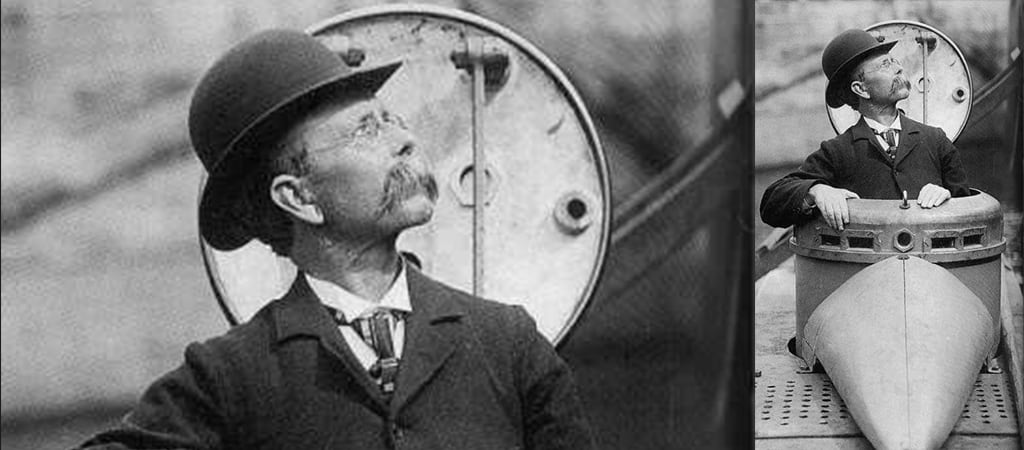
The Foundation, in partnership with New Jersey teachers, develops the S.T.E.M. aligned module “Eureka! Invention and Innovation in New Jersey” and offers it at no cost to educators and students state-wide to encourage connections, enhance learning and foster curiosity about New Jersey inventors and inventions. The module is inspired by Abram Spanel, the last private owner of Drumthwacket and prolific inventor.
Image: Often called “The Father of the Modern Submarine,” New Jersey inventor John Philip Holland successfully launched his Holland Boat No. 1 into the Passaic River at Paterson on May 22, 1878.

Drumthwacket welcomes Governor Phil Murphy and First Lady Tammy Murphy. Celebrated interior designer and native New Jerseyan Anthony Baratta is hired by Mrs. Murphy and the Drumthwacket Foundation to beautifully reappoint the public rooms.
Image: The Solarium. Photo Credit: Andrew Wilkinson.

The first floor kitchen is refurbished making it more functional for an Executive Residence.
Photo Credit: Andrew Wilkinson
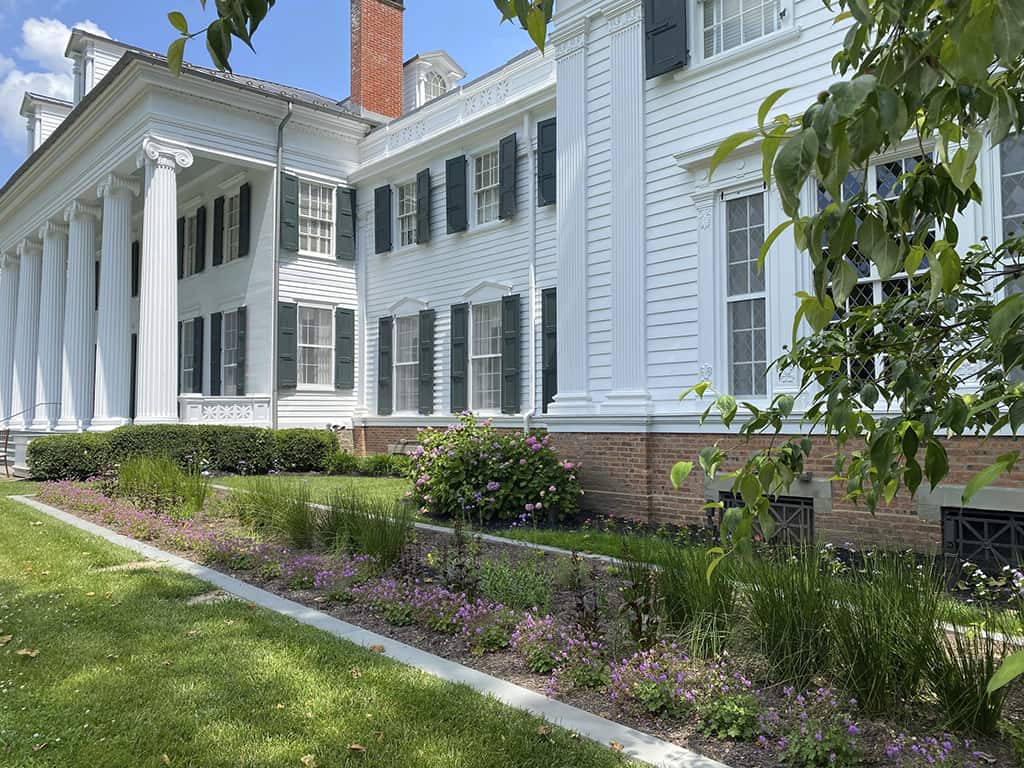
The Foundation expands its education initiatives to include sustainability. It partners with the Center for Urban Environmental Sustainability at Rutgers University to develop a Master Plan. Rain and culinary gardens and new plants and trees are added to the grounds. Bee hives, meadow establishment and composting are also planned.
Image: Drumthwacket rain garden.
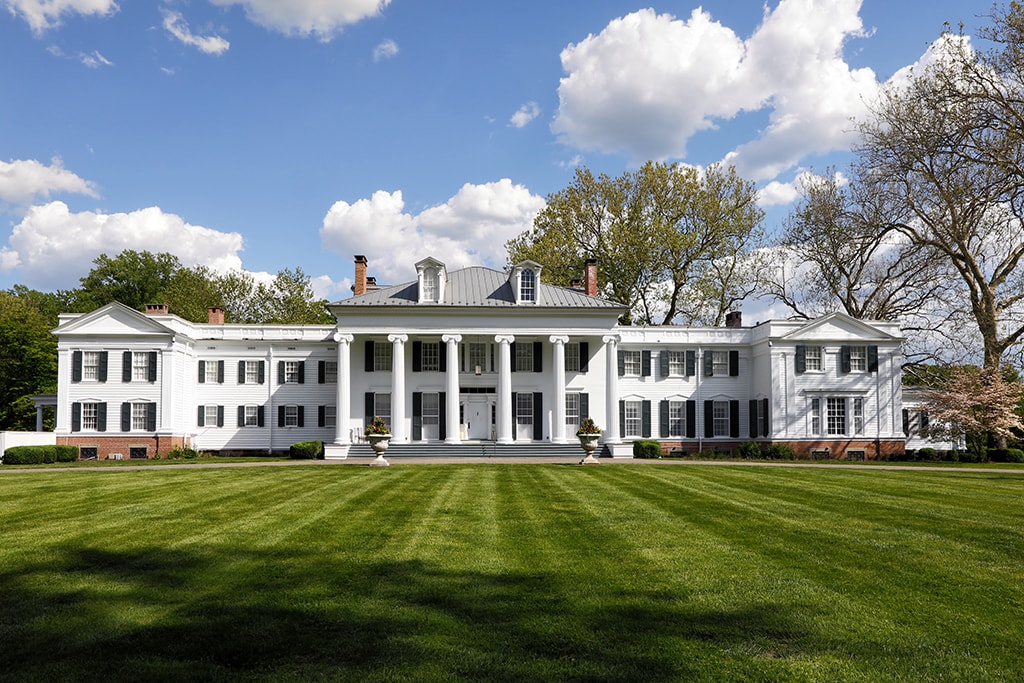
The Drumthwacket Foundation continues to serve its mission to preserve historic Drumthwacket, one of the most fabled and elegant of America’s executive residences.
Photo Credit: Andrew Wilkinson

William Penn (1644-1718) purchases a large tract of land, including Princeton and its surrounds, and encourages Quaker families to undertake its settlement. The Olden Family is one of six Quaker families who settle in the Princeton area at Stony Brook.
Image: Portrait of William Penn by Henry Inman, oil on canvas. National Portrait Gallery, Philadelphia.

William Olden (1657-1719) purchases 330 acres on the King’s Highway (now Rt. 206) which connects New York City with the largest colonial city, Philadelphia. In 1719, William’s son John Olden (1689-1757) inherits the property and divides it amongst his sons James, Benjamin and Thomas.
Image: Survey of land purchased by William Olden. Reproduced courtesy Historical Society of Princeton

Richard Stockton (1730-1781) builds Morven on land granted to his grandfather by William Penn. Stockton is a graduate of the first class of The College of New Jersey (now Princeton University) which moves from Newark to Princeton in 1756. He is one of five New Jersey delegates appointed to the Continental Congress where he signs the Declaration of Independence. Morven serves as the official residence of New Jersey governors from 1945-1981.
Image: Morven today. Photo Richard Speedy

Thomas Olden (1735-1826) sells his portion of his father’s property to John Hill who, in 1759, begins construction of a small white farmhouse. In 1772, Thomas Olden purchases back the property and farmhouse. The farmhouse, known as the Thomas Olden House today, still stands on the Drumthwacket site and is one of the few remaining original houses in the Stony Brook Quaker settlement.
Image: The Thomas Olden House, late 19th & present day.

General George Washington’s revolutionary forces defeat British forces near Princeton. Coming at the end of the “Ten Crucial Days” which witness the historic crossing of the Delaware river, the Battle of Princeton is recognized as a turning point in the Revolutionary War and occurs near present day Drumthwacket. After the battle, Washington and some of his men purportedly came to the Thomas Olden House seeking help for their wounded soldiers.
Image: Portrait of George Washington, after Charles Wilson Peale (1741-1827), oil on canvas, Long Term Loan Princeton University Art Museum

Matthew Egerton Jr. (d. 1837) joins his father Matthew Egerton’s (1739-1802) furniture shop on Burnet Street in New Brunswick, NJ and establishes it as a leading maker of cabinet and clocks in colonial America. The Drumthwacket Foundation’s collection include seven Egerton works.
Image: Tall Case Clock, bonnet detail, c, 1797. Gift of Betty Wold Johnson & Douglas F. Bushnell. The original label inside the waist door reads, “Made and sold by Matthew Egerton, Junior, Joiner and Cabinetmaker, New Brunswick, New Jersey.”

Thomas Olden’s grandson Charles Smith Olden (1799-1876) is born on the Olden farmstead. He is one of seven siblings born to Hart (1767-1841) and Temperance Smith Olden (1755-1841.)
Image: Portraits of Hart & Temperance Olden, artist unknown, oil on canvas. Inscription on reverse reads, “Painted in Princeton, 1810.” Gift of Mrs. Heather Williams and Mr. and Mrs. C. Donald Carroll.

With savings and a bequest from Charles Smith of New Brunswick, for whom he was named, Charles Smith Olden purchases his grandfather’s property and begins construction of Drumthwacket. The original structure consists of the center hall with two rooms on each side in addition to the large portico with detailed ionic columns. Olden gives the home the Scots-Gaelic name “Drumthwacket” which translates to “wooded hill.”
Image: Drumthwacket, mid to late 19th century.

Olden serves as the 19th Governor of New Jersey from 1860–1863. When the Civil War begins, he keeps New Jersey on the Union side and updates the military organization and equipment of the New Jersey troops. He reorganizes the state’s finances and sustains the treasury with his private fortune.
Image: Charles Smith Olden. Reproduced courtesy Historical Society Princeton.

Charles Smith Olden dies and is buried at the Stony Brook Meeting House and Cemetery. In his will of 1873, he leaves his lands that included 48.20 acres valued at $167,000 along with Drumthwacket and the small white farmhouse to his wife Phebe Ann Smith (d. 1892.)
Image: Portrait of Mrs. Charles Smith Olden, 1830. Thomas Sully (1783-1872.) Frick Digital Collections.

Moses Taylor Pyne (1855-1921) purchases Drumthwacket from Governor Olden’s widow for the sum of $15,024 and with his wife Margaretta Stockton Pyne (1856-1939) begins the process of transforming Drumthwacket into a 183-acre grand estate.
Image Caption Moses Taylor Pyne and Margaretta Stockton Pyne

Moses Taylor Pyne celebrates tenure as a Trustee of Princeton University, a position which he holds for 37 years. He is instrumental in bringing Woodrow Wilson to Princeton as president, and after a disagreement, having him removed.
Image: Portrait of Moses Taylor Pyne. William Sartain (1843-1924), oil on canvas. Long term loan Princeton University Art Museum. Moses Taylor Pyne is seated in academic gown with a view of Princeton University’s Pyne library in the background.

The Thomas Olden House is converted to an aviary for exotic birds and houses monkeys when Henry Egglesfield, butler to Mr. Pyne, his wife and 11 children outgrow the small farmstead. Mr. Egglesfield serves as Moses Taylor Pyne’s English Butler for forty-eight years.
Image: Photograph of Henry Egglesfield, his wife Fanny and 10 of their 11 children.

Noted architect Raleigh C. Gildersleeve is engaged to design the alterations and additions to the residence which include east and west wings.
Image: The East wing, shown, was added first to the residence.

Moses Taylor Pyne retains Daniel Webster Langton, one of the eleven founding members of the American society of Landscape Architects, to design Drumthwacket’s entire property including woods, ponds, lawns, bowling green, fountains, tennis court and the formal Italianate gardens directly behind the residence.
Image: October 1905 cover of American Home and Garden featuring the Drumthwacket estate.

Moses Taylor Pyne dies and bequeaths Drumthwacket to his only grandchild Agnes. Princeton University suspends classes for the day and bells toll throughout Princeton in memorium.
Photograph of Moses Taylor Pyne and his granddaughter Agnes, N.d.

Abram Nathanial Spanel (1901 – 1985) purchases Drumthwacket and twelve surrounding acres from Moses Taylor Pyne’s grandchild, Agnes. A Russian immigrant, Spanel is an ingenious inventor and scientist who founded in 1932 the International Latex Corporation which becomes known as the International Playtex Corporation. Spanel’s company supports American efforts in World War II with latex products such as attack boats, life rafts and canteens.
Spanel’s engineering staff lives at Drumthwacket and many of his patented inventions are conceived in what is today the Music Room. When Spanel dies, he holds more than 2,000 patents including a pneumatic stretcher designed to carry wounded military personnel in the water to a home hair-cutting device.
Music room. Photo Credit: Andrew Wilkinson

Hungarian-born physicist Leo Szilard (1898 – 1964) lives at Drumthwacket for over a year by invitation of Abram Spanel and his wife Margaret. A close friend and colleague of Princeton resident Albert Einstein (1879-1955), Szilard urges Einstein to sign the historic 1939 letter to President Franklin Roosevelt warning about German nuclear weapons research.
Image: Portrait of Albert Einstein. Samuel Johnson Woolf (1880-1948). Oil on canvas. Gift of Bernard and Bebe Perliss. The portrait is featured on the April 4, 1938 cover of Time magazine. Einstein graces the cover of Time magazine on six separate occasions including the December 31, 1999 issue in which he is named the “Man of the Century.”

Abram Spanel’s company wins a competition sponsored by NASA to develop the Apollo spacesuit. In an address to ILC employees, Abram Spanel remarks, “it is the greatest privilege of my life to present to you the role that your company played in that colossal of all human achievements in placing two American astronauts on the surface of the moon for the glory of civilization and humanity.”
Image: Custom-made by ILC employees as a training suit for Astronaut Paul Weitz who flew aboard the Skylab II mission in 1973. The suit is identical to all of the suits that were used on the Apollo 15, 16 and 17 lunar missions. Collection of ILC Industries, Dover, Delaware.

The State of New Jersey purchases Drumthwacket with the intent that it be used as the governor’s residence although it is not officially recognized as such until 1981 as funds were needed for adequate maintenance and restoration.
Image: The dining room at Drumthwacket prior to restoration. The center wall will be removed to accommodate a table that can seat 24.

The Drumthwacket Foundation is founded accepting the responsibility of restoring, curating and preserving the residence and property which are listed on the National Register of Historic Places.
Image: Hand painted wall panel, detail. In 1982, The Foundation commissioned 29 separate hand-painted wall panels for the residence’s dining room. The design consists of plum blossoms, peonies, butterflies, bees and birds. In the Chinese tradition, plum blossoms represent strength and braveness while peonies are representative of high office, prosperity and wealth.

First Lady Lucinda Florio and the Drumthwacket Foundation raise funds to rehabilitate and restore the Italianate gardens.
Drumthwacket’s Italianate garden, Present day. Photo Credit: Virginia Hall.

In 2003, the Drumthwacket Foundation hosted the first annual Easter Egg Hunt for Children with Special Needs. While the annual event is now held as a Spring Carnival, it continues to delight children and their families. Bounce houses, live music, balloon twisters, pony rides, carnival games and treasure hunt make for a memorable day and beloved Foundation tradition

First Lady Mary Pat Christie and the Drumthwacket Foundation launch a comprehensive four year facilities plan to restore the exterior of the residence and Thomas Olden House, re-grade walk surfaces for wheelchair accessibility, install energy efficient path lighting, add new landscaping, exterior signage and update the public restrooms.
Residence exterior, detail. Photo Credit: Virginia Hall

The Foundation in partnership with New Jersey teachers develops the S.T.E.M. aligned module “Eureka! Invention and Innovation in New Jersey” and offers it at no cost to educators and students state-wide to encourage connections, enhance learning and foster curiosity about New Jersey inventors and inventions. The module is inspired by Abram Spanel, the last private owner of Drumthwacket and prolific inventor.
Image: Often called “The Father of the Modern Submarine,” New Jersey inventor John Philip Holland successfully launched his Holland Boat No. 1 into the Passaic River at Paterson on May 22, 1878.

Drumthwacket welcomes Governor Phil Murphy and First Lady Tammy Murphy. Celebrated interior designer and native New Jerseyan Anthony Baratta is hired by Mrs. Murphy and the Drumthwacket Foundation to beautifully reappoint the public rooms.
Image: The Solarium. Photo Credit: Andrew Wilkinson.

The first floor kitchen is refurbished making it more functional for an Executive Residence.
Photo Credit: Andrew Wilkinson

The Foundation expands its education initiatives to include sustainability. Rain and culinary gardens and new plants and trees are added to the gardens and grounds. Bee hives, meadow development and composting are also planned.
Image: Drumthwacket rain garden.

The Drumthwacket Foundation continues to serve its mission to preserve historic Drumthwacket, one of the most fabled and elegant of America’s executive residences.
Photo Credit: Andrew Wilkinson
